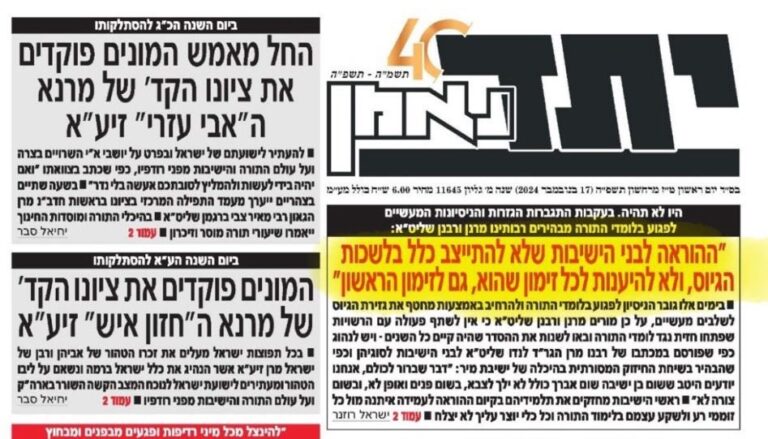 (From the OU) Given the strict Torah prohibitions against eating insects – there are five Torah commandments against eating crawling insects and six against consuming flying insects – and the tendency of bugs to find fruits and vegetables as much a part of their lifestyle as people do, it has become extremely important to check veggies and fruits for insect infestation to be certain they are kosher.
(From the OU) Given the strict Torah prohibitions against eating insects – there are five Torah commandments against eating crawling insects and six against consuming flying insects – and the tendency of bugs to find fruits and vegetables as much a part of their lifestyle as people do, it has become extremely important to check veggies and fruits for insect infestation to be certain they are kosher.
Unlike other foods, in which the OU certification mark is the guarantee of the highest levels of kashrut, fresh fruits and vegetables – unless they come packaged — usually do not carry kosher certification. In cases, however, in which individual products do carry the OU certification mark, it is not necessary to do further checking. In other instances, the consumer has to check for the presence of bugs, particularly thrips and aphids, by no means an easy task. Another species, the vegetable leafminer, which digs itself into the vegetable, is even harder to detect. So the kosher consumer, in effect, becomes a mashgiach, checking at home for the bugs which can render one’s veggies treif.
Products such as lettuce (leaf and romaine), spinach, broccoli, parsley, scallions, Spanish onions, asparagus, strawberries and the like must undergo careful inspection before they are eaten. To provide expert advice on how to do this, the Orthodox Union has just posted on its ouradio.org website a video program – that’s right, a video on OU Radio — “The Checking of Vegetables and Fruits.” The video, which runs 45 minutes, is part of the OU Kosher Tidbits series, in which OU experts provide guidance on everything from soup to nuts. The vegetables and fruits segment is the first among the more than 80 already posted that is a video, rather than an audio presentation.
According to Rabbi Dr. Eliyahu Safran, Senior Rabbinic Coordinator and Vice President of Communications and Marketing of OU Kosher, who coordinates the series, “Kosher Tidbits is developing into a ‘storehouse of information’ in all areas and facets of kosher certification and observance. The proper checking of fruits and vegetables to be sure that they are insect free is a most important element of kashrut observance. Therefore OU Kosher is adding to its ever-growing Kosher Tidbits collection an audio-visual presentation on this vital aspect of kosher law.” The program is in video rather than audio format, he explained, because “It cannot just be the spoken word, but must be seen.”
The Mission of Kosher Tidbits:
“Kosher Tidbits is a key element of the mission of OU Kosher to educate the community in the intricacies of kashrut,” declared Dr. Simcha Katz, Chair of the OU Kashrut Commission. “With the progression from strictly audio to audio-visual, a further step has been taken in expanding our programming and to make it as instructive and as useful as possible. Watching and listening to the OU experts will provide a handy guide to what is a very important aspect of maintaining proper kashrut in the home.” Dr. Katz added, “The same techniques are used in restaurants that are certified by the OU.”
The video features Rabbi Shimon Yoffe, OU Rabbinic Field Representative, doing the debugging, with OU Kosher Rabbinic Coordinator Rabbi Leonard Steinberg serving as narrator. They are, according to Rabbi Safran, “two of the world’s finest experts” in the field.
Engaging in what he termed “demystifying the process of checking vegetables and fruits,” Rabbi Steinberg declared that contrary to popular belief, “it’s not impossible to do. Anyone with decent eyesight should be able to do it.” Rabbi Yoffe, who used a light box in his demonstrations, advises consumers to purchase this piece of equipment to make the job easier.
The problem of insect infestation arose in the mid-1980’s, Rabbi Steinberg explained, when increasingly powerful insecticides were banned because of their dangers to humans; the beneficiaries of government regulation were, of course, the bugs.
Utilizing vats of water for rinsing as well as his light box, Rabbi Yoffe showed a variety of techniques for handling different vegetables. Demonstrating romaine lettuce, he first washed a leaf, then placed it on the box, turning it over carefully as Rabbi Steinberg provided narration. “You must open up all of the folds in the leaf because this is where they may hide,” Rabbi Steinberg advised. Because a piece of dirt may be mistaken for an insect, magnifying glasses come in handy, he said. A knife will also be useful for some varieties, for cutting into stalks or removing troublesome areas.
The Nuances of Spinach, Etc:
Each product has its nuances. Spinach, which according to Rabbi Steinberg is “usually badly infested,” requires special attention to the area between the stem and the leaf. Curly parsley, he said, “is very difficult to check because of crevices where it’s possible for bugs to hide.” Scallions can be “highly infested,” while asparagus is “a very tough vegetable. The head is a very good place for insects to hide, so behead it,” he said. Thus, the knife.
With strawberries, insects prefer hiding under the greenery at the top, but also in the clefts. Consequently, as Rabbi Yoffe demonstrated and Rabbi Steinberg explained, strawberries must go through a variety of steps. “They are washed in dish soap, agitated very well, rubbed with your fingers, washed off in a strong stream of water and checked visually using overhead light.” Blackberries and raspberries are so tough to check that they shouldn’t be eaten in a kosher home, Rabbi Steinberg said.
Even more help is on the way to make certain that these tiny and less than appetizing creatures do not violate the standards of a kosher home. In August, the OU will publish its updated OU Guide to Checking Fruits, Vegetables and Berries, Rabbi Safran announced. The new version is edited by Rabbi Dovid Bistricer, OU rabbinic coordinator of many OU certified vegetable companies, who together with Rabbi Steinberg, “has developed great expertise in the field,” Rabbi Safran declared. The Guide will be available for purchase on shopou.org
With the video now available and then the Guide, the search for thrips, aphids and their insect brethren will be done with greater skill and knowledge – and knowledge is what Kosher Tidbits is all about.











11 Responses
Can you provide the link to the video please?
This is the link to Kosher Tidbits:
http://www.ouradio.org/ouradio/channel/C301/
and this is the link to the video:
(is for Cable/DSL – there was no link for dial up)
http://www.ouradio.org/index.php/ouradio/ouradio_asx/14876/ou.asx
THERE YOU GO
http://www.ouradio.org/index.php/ouradio/ouradio_asx/14876/ou.asx
There’s an audio clip for a few seconds before it actually starts.
http://www.ouradio.org/ouradio/ouradio_asx/14876/ou.asx
I don’t mean to be picky, bt i always thought that it was 3 torah commandments against eating swimming insects, 4 against eating land insects, and 5 against flying insects??
So is this article actually from the OU? I ask because I want to quote it in an article I’m thinking of writing.
So where do I buy one of those light box things?
Reb Motcha,
You can buy them in any art supply store.
Ok, thanks!
So now I have to find an art supply store in Monsey. How long will it be before the seforim stores begin selling these things?
the seforim stores have them
You can ask someone to buy one for you from Israel. They are the boxes they use for the house numbers… same thing.